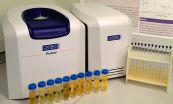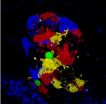INFORMATION:
Institute of Food Research announces test for horse meat
2014-12-01
(Press-News.org) Scientists at the Institute of Food Research on the Norwich Research Park have teamed up with Oxford Instruments to develop a fast, cheap alternative to DNA testing as a means of distinguishing horse meat from beef. Because horses and cattle have different digestive systems, the fat components of the two meats have different fatty acid compositions, as the team report in the journal 'Food Chemistry'. The new method looks at differences in the chemical composition of the fat in the meats, using similar technology to a hospital MRI scanner.
In just ten minutes, a technician can determine whether a piece of raw meat is horse or beef. The method, developed with funding from Innovate UK and the Biotechnology and Biological Sciences Research Council (BBSRC) has recently been trialled in an industrial setting by a leading meat processor. It is currently being extended by the team of scientists to test for other meat species, including pork and lamb.
The horse meat scandal of 2013 was sparked by the discovery of horse meat in a number of beef burgers. Soon, horse meat was detected in other meat products, leading to millions of pounds worth of food being taken off supermarket shelves. The crisis exposed the potential vulnerability of the meat supply chain to fraud and even to threats to public health, and highlighted gaps in testing. The currently favoured method of meat species testing relies on DNA, which can tell one meat from another based on the genetic makeup of the source animals, but is relatively slow and expensive and prone to contamination if not used carefully.
In response to this, a new method using a totally different approach was developed by Oxford Instruments and IFR. The key technology is the 'Pulsar', a high resolution bench-top NMR spectrometer developed by Oxford Instruments. NMR spectroscopy is a well-respected analytical technique used in chemistry labs worldwide. However, conventional instruments are large and expensive, and rely on super-cooled magnets and highly trained personnel to run them. Pulsar in contrast is based on permanent magnets and ease of operation.
For a test to be useful as a screening tool it needs to be quick and cheap. With this goal in mind, the team discovered that a couple of minutes shaking about a gram of meat in a solvent followed by a few minutes of data acquisition on Pulsar was enough to tell horse meat from beef. Software to carry out mathematical analysis of the spectral data has also been developed at IFR.
"It's a stroke of luck really that some of the most important meats turn out to have fat signatures that we can tell apart so easily with this method", says Dr Kate Kemsley. "It's been very satisfying to see results from a real industrial setting sit right on top of those we generated in our two labs. We think this testing method should work well at key points in the supply chain, say at meat wholesalers and processors."
ELSE PRESS RELEASES FROM THIS DATE:
Big city health departments lead the way in improving population health
2014-12-01
December 1, 2014 - The health departments of the nation's largest cities play a central role in developing innovative population health strategies for improving public health across the United States, according to a special January issue of the Journal of Public Health Management and Practice. The journal is published by Lippincott Williams & Wilkins, a part of Wolters Kluwer Health.
"Indeed, cities are at the forefront in extending public health and social policy to realize changes in our environment abetting population health," according to a commentary by Lloyd F. ...
Prompt, appropriate medical care for dislocated shoulder injuries
2014-12-01
ROSEMONT, Ill.--Prompt and appropriate treatment of a dislocated shoulder--when the head of the upper arm bone (humerus) is completely knocked out of the shoulder socket (glenoid)--can minimize risk for future dislocations as well as the effects of related bone, muscle and nerve injuries, according to a literature review appearing in the December issue of the Journal of the American Academy of Orthopaedic Surgeons (JAAOS).
The shoulder has the greatest range of motion of any joint in the human body and is the most common site for a full or partial dislocation. Shoulder ...
Possible read head for quantum computers
2014-12-01
This news release is available in German. Ideally, diamonds consist of pure carbon. But natural diamonds always contain defects. The most researched defects are nitrogen-vacancy centers comprising a nitrogen atom and a vacancy. These might serve as highly sensitive sensors or as register components for quantum computers. However, until now it has not been possible to extract the optically stored information electronically.
A team headed by Professor Alexander Holleitner, physicist at the TU München and Frank Koppens, physics professor at the Institut de Ciencies ...
Review of 90 studies confirms that men's sperm quality declines with age
2014-12-01
Conflicting evidence about the extent to which men's semen quality declines with age--likely lowering their fertility--is being cleared up by new University of Otago, New Zealand, research that has collated and reviewed data from 90 previous studies from around the world.
After conducting a systematic review and meta-analysis of the studies' data, researchers from the University's Departments of Zoology and Anatomy found consistent age-related declines in semen volume and sperm performance and increases in malformed and DNA-damaged sperm. Semen quality is regarded as ...
Singapore scientists uncover gene associated with an aggressive breast cancer
2014-12-01
Singapore--Scientists at A*STAR's Genome Institute of Singapore (GIS), in collaboration with local clinicians and colleagues in the USA, have identified a biomarker which is strongly associated with triple negative breast cancer (TNBC), a highly aggressive carcinoma that often has early relapse and metastasis following chemotherapy. The newly identified biomarker, a gene called RASAL2, provides a target for developing new therapeutics designed to treat this often deadly disease.
TNBC is deadly because, unlike other types of breast cancers such as estrogen receptor (ER) ...
Genes and environment: Complex interactions at the heart of personalized medicine
2014-12-01
Personalized medicine uses methods of molecular analysis, especially genetic sequencing and transcription, in order to simultaneously identify genetic mutations to evaluate each individual's risk of contracting a given disease. It seems that there is more than a single mechanism at hand, as proven by the work of a team of geneticists at the University of Geneva's (UNIGE) Faculty of Medicine, and the Swiss Institute for Bioinformatics (SIB). They have sequenced the RNA of 400 pairs of twins; with this information, they can quantify the roles of both genetic and environmental ...
Taking the 'mute' off silenced gene may be answer to Angelman syndrome
2014-12-01
HOUSTON -- (Dec. 1, 2014) - Most genes are inherited as two working copies, one from the mother and one from the father. However, in a few instances, a gene is imprinted, which means that one copy is silenced. This is called genomic imprinting. If the active copy is mutated, then disease results, even though the silenced gene copy may be normal.
Angelman syndrome, which causes learning difficulties, speech problems, seizures, jerky movements and an unusually happy disposition, results when a gene inherited from the mother in a particular area of chromosome 15 is mutated ...
Penn study points to new therapeutic strategy in chronic kidney disease
2014-12-01
PHILADELPHIA-- Chronic kidney disease (CKD) affects at least one in four Americans who are older than 60 and can significantly shorten lifespan. Yet the few available drugs for CKD can only modestly delay the disease's progress towards kidney failure. Now, however, a team led by researchers at the Perelman School of Medicine at the University of Pennsylvania, has found an aspect of CKD's development that points to a promising new therapeutic strategy.
"We found that a defect in energy production in affected kidney cells plays a key role in CKD development," says Katalin ...
Neuronal encoding of the switch from specific to generalized fear
2014-12-01
"I can't get the memories out of my mind!... I am right back in Vietnam, in the middle of the monsoon season at my guard post. My hands are freezing, yet sweat pours from my entire body...I smell a damp sulfur smell. Suddenly I see what's left of my buddy Troy, his head on a bamboo platter, sent back to our camp by the Viet Cong."i
This veteran of the US army, who served in Vietnam, has intense flashbacks of his decapitated friend whenever he hears a clap of thunder, touches a bamboo mat, or sees an Oriental woman. Although the traumatic incident happened decades ago in ...
Scientists discover why bowel cancer sometimes outsmarts treatment
2014-12-01
A new study* that challenges the prevailing view of how bowel cancer develops in the large intestine is published today in Nature Medicine.
Cancer Research UK scientists have discovered that bowel cancer may not be restricted to starting its journey in the stem cells in the lining of the intestines as previously thought.
The researchers, based at the Wellcome Trust Centre for Human Genetics, studied a hereditary faulty gene which can cause bowel cancer in middle age. The faulty gene causes normal cells to behave like immortal stem cells and develop tumours of their ...


